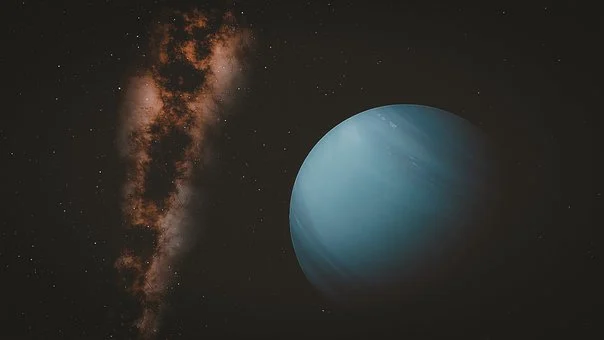James Webb Space Telescope capture new images of Neptune with its shiny, dusty rings

Neptune is the eighth planet from the sun and the farthest known solar planet. It was discovered in 1846. It is characterized as an ice giant. It is characterized as an ice giant due to the chemical makeup of its interior. Compared to the gas giants, Jupiter and Saturn, Neptune is much richer in elements heavier than hydrogen and helium. Neptune has six narrow rings.
James Webb Telescope is the World's premier space science observatory. Webb is an international program led by NASA with its partner's European Space Agency and Canadian Space Agency. Webb will help in solving many solar mysteries in further future.

Around 32 years ago, NASA launched the spacecraft Voyager 2. It discovered that Neptune has five moons, four rings, and a "Great Dark Spot". Now, the James Webb Space Telescope has captured the clearest pictures of Neptune's rings.

It has been three decades since we last saw these faint, dusty rings, and this is the first time we’ve seen them in the infrared,” notes Heidi Hammel, a Neptune system expert and interdisciplinary scientist for Webb. Webb’s extremely stable and precise image quality permits these very faint rings to be detected so close to Neptune.
The signature appearance of Neptune is blue as discovered by Hubble Space Telescope. But it doesn't appear to be blue in the Webb telescope because the Near-Infrared Camera only images objects from 0.6 to 5 microns. The methane gas absorbs the red and infrared light so strongly, due to which the planet is quite dark at this range.
A thin line of brightness circling the planet's equator could be a visual signature of global atmospheric circulation that powers Neptune’s winds and storms. The atmosphere descends and warms at the equator, and thus glows at infrared wavelengths more than the surrounding, cooler gases.
The northern area of Neptune is out of view for astronomers but the Webb images hint at an intriguing brightness in that area. A previously-known vortex at the southern pole is evident in Webb’s view. Webb has revealed a continuous band of high-latitude clouds surrounding it.
The Webb telescope also captured 14 moons of Neptune. The large bright spiky point seen in the recent Webb captured images is not the star, it is Neptune's large and unusual moon, Triton. It reflects around 70 percent of the sunlight thus it is outshining the planet in the image as the usual atmosphere of Neptune is darkened by Methane absorption. Triton orbits Neptune in a backward orbit. This moon was originally a Kuiper belt object that was gravitationally captured by Neptune.
In the coming years, there will be more studies and discoveries related to Neptune and Triton.
Story Source:
Materials provided by NASA. The original text of this story is licensed under a Creative Commons License. Note: Content may be edited for style and length.
Journal Reference:
Laura Betz
NASA's Goddard Space Flight Center, Greenbelt, Md.
Hannah Braun
Space Telescope Science Institute, Baltimore, Md.
Christine Pulliam
Space Telescope Science Institute, Baltimore, Md
0 Comments